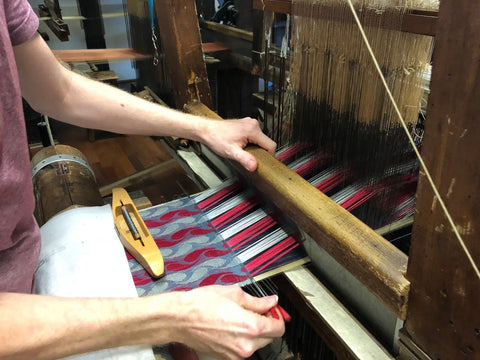The Indian textile industry is ruling the world with its vibrant hues, intricate patterns, and high-quality fabric. From the ancient period to the modern world, we have been crafting elegant designs for the last 5000 years. And the list of factors contributing to making our textile industry so popular is dominated by Indian handloom manufacturing and its highly skilled weavers. India has always been known for its exquisite patterns and unmatchable craftsmanship. And when the handloom industry enters into the conversation, jacquard weaving becomes part of the discussion. So, why not dig up further to know our heritage from the history of jacquard weaving to jacquard in the present scenario?
What is Jacquard Weave
It is a kind of fabric that is woven on jacquard looms with pre-determined patterns with a blending of multiple shades. Jacquard weaving creates a pattern in the fabric with a complex in-built design structure. Usually, Jacquard loom works all fabrics but majorly brocade, damask, and brocatelle are majorly produced on the loom.

History and Origin of Jacquard Weaving
Before the origin of Jacquard Loom, weavers used to produce this luxury fabric by hand and it was popularly known as brocade during the 4th century. With the progress of silk fabric manufacturing, weavers used to design patterns on more delicate fabric for a more aesthetic appearance.
Modern Jacquard weaving started in 1804 when Joseph Marie Jacquard, a French textile artisan invented this specific loom. Earlier, this fabric was a symbol of the elite class owing to its expensive price and limited weaving but after the 18th century, Jacquard suddenly became a fabric that average people can access.

Image credit sachumacher
In India, Jacquard weave was introduced during the British Empire and became a crucial part of our handloom industry. Today it is used to produce varieties of clothes like saris, tapestries etc.
Methods and Process of Jacquard Weave
Methods
Jacquard loom creates a harmonious blend of vibrant shades and intricate patterns. Traditionally, it was done through punch cards but now a number of methods are available.
Punch Card
The most traditional Jacquard weaving process is punch card where cards punching in looms decide whether waft thread should be raised or not. Cards are arranged in such a sequence that ensures that they create the desired pattern.
Computerized Jacquard
This is an evolved version of the punch card Jacquard method where cards are controlled and functioned by the computer. A computer reads the pattern and then instructs the loom to craft the patterns.
Double-Lift Jacquard
Unlike the other Jacquard method, each warp thread is controlled by two hooks in double-lift Jacquard. This straightens more flexibility and an intricate pattern into the fabric. With this method, the fabric gets a more detailed weave structure.
Hand Jacquard
Despite many evolved versions of the Jacquard weaving process, some artists still use hand Jacquard looms. In this method, all the warp is controlled by the weavers manually. It builds a connection between weavers and fabric.
Cardless Jacquard
Technology advancement pushed Jacquard weaving a step further. Now the machine does not need any punch cards as modern software drafts patterns and designs without punching cards.
Process
The process of manufacturing jacquard fabric is universal yet myriad textile fibers can be used to create jacquard fabric. The process of Jacquard fabric is as follows:
Acquire Raw Material
The market is flooded with a number of textile materials. And the process of the Jacquard pattern starts with picking textile fiber. Weavers can pick anyone from cotton to wool.
Spin Into Yarn
After selecting textile fiber, the next step leads to manufacturing yarn from fibers. Manufacturers could choose a variety of thickness options for yarn. Often, many post-spinning treatments are also used to enhance the fabric's durability.
Select The Pattern
After spinning the yarn, the next step is to pick the desired pattern for weaving. Weavers either choose crafted patterns or create new ones. Selecting patterns instructs machines to weave yarn in a specific pattern only.
Post-Production Treatment
Some weavers soak the fabric into chemical substances to add durability and others choose to dye the fabric.
Jacquard Weaving Today
No wonder, Jacquard weaving has changed over the years dramatically. Jacquard fabric is used for a variety of home furnishings like jacquard curtains, and jacquard cushion covers.
Conclusion
Jacquard is a spectacular piece of fabric that has not lost its charm and beauty since its origin in the 4th century. Despite computerized methods, Jacquard weaving maintains a heritage touch through small weavers. In order to promote such artisans, iTokri has an exquisite collection of Jacquard fabric curated by the weavers of Tamil Nadu. From elegant home decor items to jacquard nightsuits, we have something for everyone.
FAQs
What kind of fabric is Jacquard?
Jacquard is a type of fabric that has patterns and motifs crafted during the weaving of fabric with a tapestry effect. This fabric comes in a large variety from embellished damask to simple florals.
How is a Jacquard weave made?
The Jacquard weave was made through a special loom that used thousands of punch cards to create patterns on weaving fabric.
What is jacquard weave fabric for?
Jacquard woven fabric is majorly used for home decor, apparel, upholstery, draperies, curtains, etc.
 Verified Purchase
Verified Purchase











































































































































































































Leave a comment (all fields required)